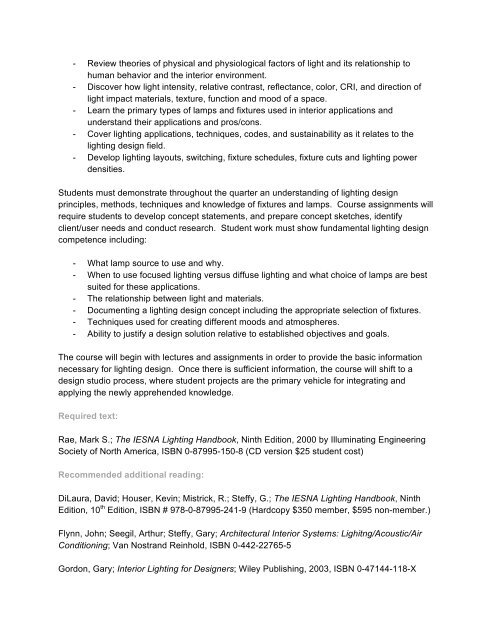Arch 577 Lighting Design - USC School of Architecture
Arch 577 Lighting Design - USC School of Architecture
Arch 577 Lighting Design - USC School of Architecture
You also want an ePaper? Increase the reach of your titles
YUMPU automatically turns print PDFs into web optimized ePapers that Google loves.
- Review theories <strong>of</strong> physical and physiological factors <strong>of</strong> light and its relationship to<br />
human behavior and the interior environment.<br />
- Discover how light intensity, relative contrast, reflectance, color, CRI, and direction <strong>of</strong><br />
light impact materials, texture, function and mood <strong>of</strong> a space.<br />
- Learn the primary types <strong>of</strong> lamps and fixtures used in interior applications and<br />
understand their applications and pros/cons.<br />
- Cover lighting applications, techniques, codes, and sustainability as it relates to the<br />
lighting design field.<br />
- Develop lighting layouts, switching, fixture schedules, fixture cuts and lighting power<br />
densities.<br />
Students must demonstrate throughout the quarter an understanding <strong>of</strong> lighting design<br />
principles, methods, techniques and knowledge <strong>of</strong> fixtures and lamps. Course assignments will<br />
require students to develop concept statements, and prepare concept sketches, identify<br />
client/user needs and conduct research. Student work must show fundamental lighting design<br />
competence including:<br />
- What lamp source to use and why.<br />
- When to use focused lighting versus diffuse lighting and what choice <strong>of</strong> lamps are best<br />
suited for these applications.<br />
- The relationship between light and materials.<br />
- Documenting a lighting design concept including the appropriate selection <strong>of</strong> fixtures.<br />
- Techniques used for creating different moods and atmospheres.<br />
- Ability to justify a design solution relative to established objectives and goals.<br />
The course will begin with lectures and assignments in order to provide the basic information<br />
necessary for lighting design. Once there is sufficient information, the course will shift to a<br />
design studio process, where student projects are the primary vehicle for integrating and<br />
applying the newly apprehended knowledge.<br />
Required text:<br />
Rae, Mark S.; The IESNA <strong>Lighting</strong> Handbook, Ninth Edition, 2000 by Illuminating Engineering<br />
Society <strong>of</strong> North America, ISBN 0-87995-150-8 (CD version $25 student cost)<br />
Recommended additional reading:<br />
DiLaura, David; Houser, Kevin; Mistrick, R.; Steffy, G.; The IESNA <strong>Lighting</strong> Handbook, Ninth<br />
Edition, 10 th Edition, ISBN # 978-0-87995-241-9 (Hardcopy $350 member, $595 non-member.)<br />
Flynn, John; Seegil, Arthur; Steffy, Gary; <strong>Arch</strong>itectural Interior Systems: Lighitng/Acoustic/Air<br />
Conditioning; Van Nostrand Reinhold, ISBN 0-442-22765-5<br />
Gordon, Gary; Interior <strong>Lighting</strong> for <strong>Design</strong>ers; Wiley Publishing, 2003, ISBN 0-47144-118-X

















